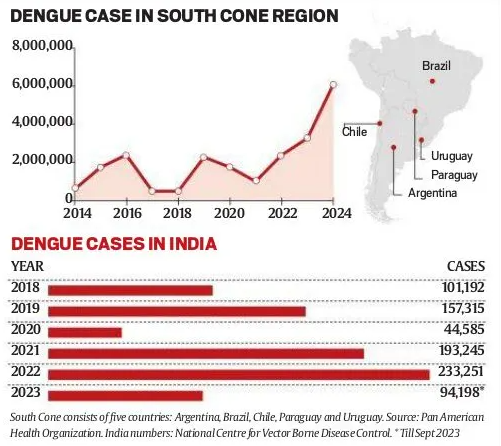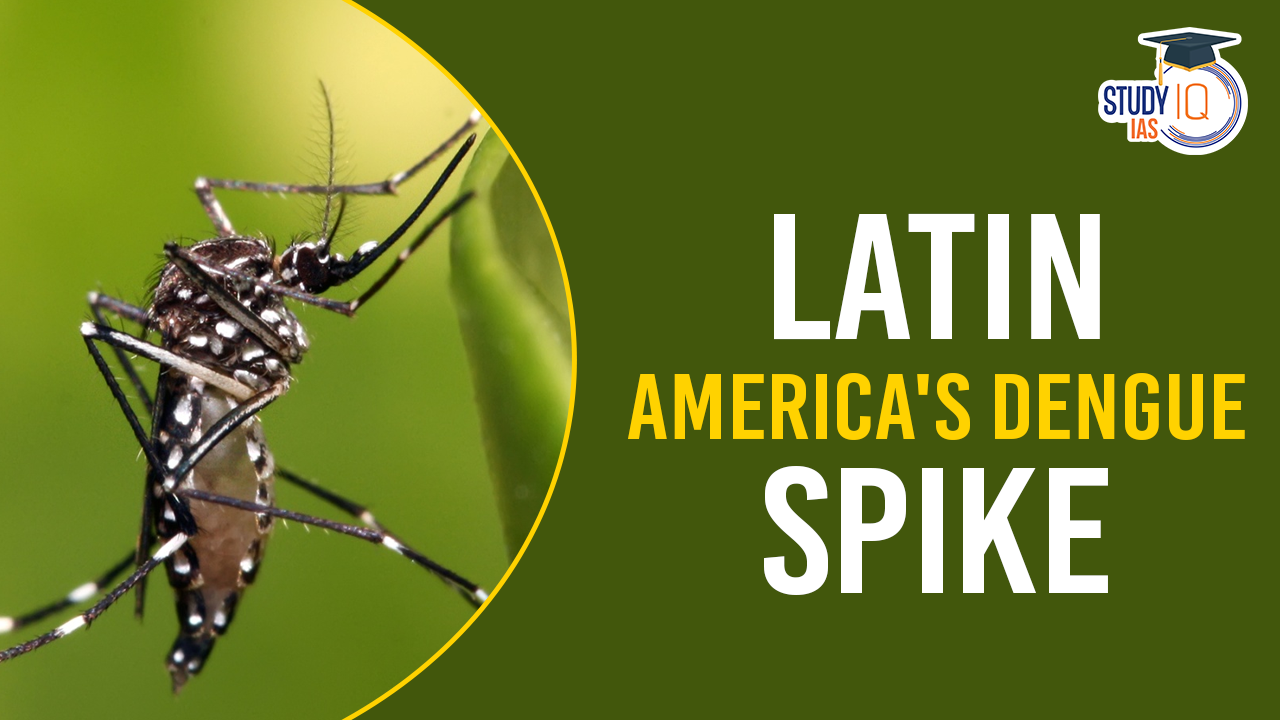Table of Contents
Context: Dengue cases in Latin America and the Caribbean have surged, with over 5.9 million cases reported from January to April 2024, surpassing the 4.4 million total cases recorded in all of 2023.
Worst-Hit Countries of Dengue in Latin America
- Brazil: The most affected country with over 4.2 million cases as of April 23, accounting for 1.8% of its population.
- Over 2,000 deaths have been recorded, marking the highest single-year fatality toll.
- Several states have declared a state of emergency. Army field hospitals were set up to accommodate overflow patients, while mosquito repellents have sold out.

- Peru and Puerto Rico: Both declared a state of emergency due to spikes in dengue cases. Puerto Rico reported 549 cases by March, up from 1,293 in 2023. Peru recorded 135,000 suspected cases and 117 deaths between January and April compared to 33 deaths last year.
- Argentina: A significant rise in cases was reported.
- Central American Countries and Mexico: Typically experiencing a rise in dengue towards the year’s end, these regions are already seeing increased cases.
- Uruguay and Chile: These countries, historically unaffected, are now experiencing severe outbreaks.
Reasons Behind the Surge of Dengue Spike
- Climate Change: The region warmed by an average of 0.2°C per decade over the last 30 years. Warmer temperatures have led to increased mosquito populations and extended seasons of mosquito activity. El Niño exacerbated this by causing abnormal surface water warming.
- Extreme Weather: Storms, floods, and rising sea levels create stagnant water pools, while droughts force people to store water, providing breeding sites for mosquitoes.
- Urbanisation: Poor infrastructure and refuse collection services have turned shantytowns into breeding grounds due to abundant standing water.
Challenges with Dengue Vaccines
- Multiple Strains: Dengue has four strains, making it difficult to develop a single vaccine that protects against all of them.
- Partial Immunity Risk: Some vaccines can increase susceptibility to other dengue strains if a person hasn’t been previously infected.
- Dengvaxia vaccine is only suitable for those with previous dengue infections, limiting its use.
- Cost and Availability: Existing vaccines can be expensive (like Qdenga), limiting widespread use, especially in most affected regions.
- The Qdenga vaccine costs $115 per dose in Europe and $40 in Indonesia.
Promising New Vaccines
- NIH-Butantan Vaccine: Developed by the US National Institutes of Health and licensed by Brazil’s Instituto Butantan, this single-shot vaccine shows strong potential but is still years away from large-scale rollout.
Vaccine Trials in India
- Serum Institute of India (SII): Serum Institute of India is conducting Phase 3 trials on an NIH-based vaccine in collaboration with Indian Council of Medical Research (ICMR).
- Panacea Biotec is also conducting trials on the NIH vaccine.
- Indian Immunologicals Ltd is developing a vaccine based on NIH technology.
- Indigenous Vaccine Development:
- The International Centre For Genetic Engineering And Biotechnology (ICGEB) is working on a sub-unit vaccine containing only a portion of the virus.
- Tata Institute of Fundamental Research (TIFR) and Rajiv Gandhi Centre are developing a DNA vaccine.
- Both indigenous vaccines have yet to undergo clinical trials.


 Waqf Act (Amendment) 2025: Key Highlight...
Waqf Act (Amendment) 2025: Key Highlight...
 List of Military Exercises of India 2024...
List of Military Exercises of India 2024...
 Places in News for UPSC 2025 for Prelims...
Places in News for UPSC 2025 for Prelims...





















